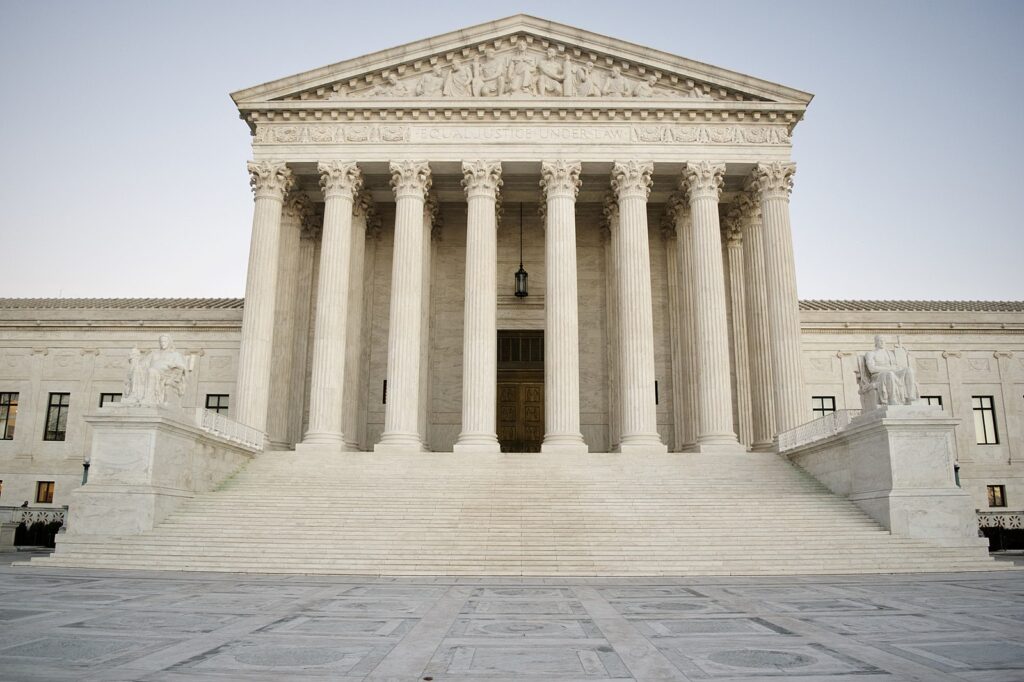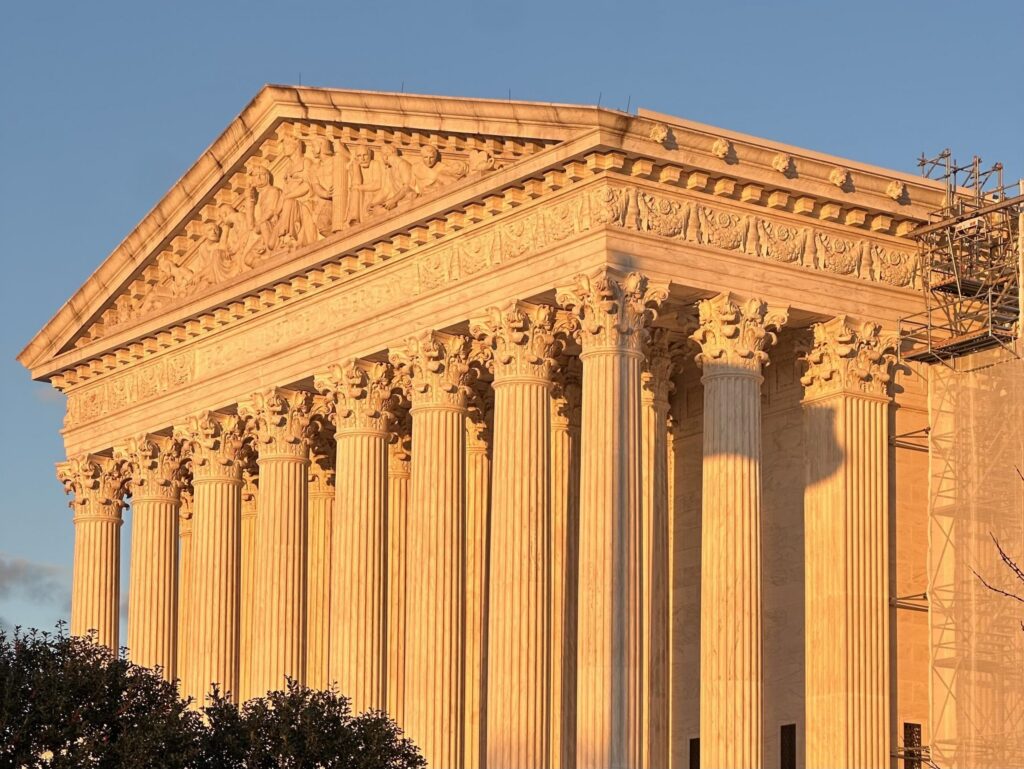
[ad_1]
ARGUMENT ANALYSIS
on Jan 10, 2024
at 5:48 pm
The justices heard oral argument in Smith v. Arizona on Wednesday. (Jesse Collins, Wikimedia Commons)
The Supreme Court on Wednesday appeared sympathetic to an Arizona man who contends that his constitutional rights were violated when an expert witness testified for the prosecution about drug analysis performed by another forensic scientist’s. Jason Smith alleges that the expert’s testimony contravened the Sixth Amendment’s confrontation clause, which gives defendants in criminal cases the right to “be confronted with the witnesses against him,” and a majority of the justices seemed inclined to agree with him.
Smith was convicted and sentenced to four years in prison after police officers executing a search warrant found methamphetamine and marijuana in a shed on his father’s property. Greggory Longoni, a forensic scientist from the state’s Department of Public Safety, testified at Smith’s trial that the substances the officers found were indeed illegal drugs. Longoni relied on testing conducted by another DPS scientist, Elizabeth Rast, who no longer worked for the state and did not testify.
Representing Smith on Wednesday, lawyer Hari Santhanam told the justices that Longoni had “no personal knowledge of the testing that Rast performed.” Instead, Santhanam said, Longoni simply “conveyed Rast’s statements from her own documents.” And when he “purported to give his own opinions,” Santhanam continued, Longoni just recited “verbatim the same statements that Rast made in her report to set forth her conclusions.” The state courts, Santhanam explained, applied the “legal fiction” that an expert can state the basis for his conclusions “without offering the basis for the truth,” but the use of Rast’s documents in this case violated the confrontation clause.
Deputy U.S. Solicitor General Eric Feigin, representing the federal government, staked out a middle ground. He agreed that Longoni’s testimony “may have gone too far” but suggested that there would be no confrontation clause problem if an expert witness testifies to “the expert’s bare fact of the bottom-line conclusion that the expert’s drawn” – for example, that the substances found on the property belonging to Smith’s father are indeed drugs. “The problem,” Feigin acknowledged, “comes in when evidence surrounding that” conclusion is admitted.
But Alexander Samuels, representing the state of Arizona, took a harder tack. Evidence that is not offered to demonstrate that the expert’s testimony is true does not violate the confrontation clause, he insisted. In this case, Samuels said, Longoni was not a “conduit” for Rast’s work. Instead, Samuels asserted, Longoni formed “independent conclusions” based on Rast’s notes and computer-generated graphs in her work, and he testified about those conclusions.
The justices focused on two main points at Wednesday’s oral argument. The first was what purpose Rast’s documents had served at trial. Had they truly been used only as the basis for Longoni’s testimony, as the state contends and the Arizona courts concluded?
Justice Clarence Thomas was among the justices who expressed skepticism that Rast’s documents were not introduced to show that Longoni’s testimony was true. If Rast’s analysis were inaccurate, Thomas posited, then Longoni’s testimony would not help the state. The state’s proposed rule, Thomas said, would create “friction” with the confrontation clause if the truth “is necessary in order for the opinion to be useful.”
Justice Samuel Alito echoed Thomas’s point. “An expert’s opinion is always worthless” unless the underlying facts on which the expert relied are true, Alito told Samuels. In this case, Alito observed, if Rast’s documents are not used to show that Longoni’s statements are true, “there’s the problem of whether those facts are proved.” What evidence is there, he asked Samuels, that the substances found on Smith’s father’s property were in fact methamphetamine and marijuana?
Samuels noted that the drugs found on the property had been physically present as exhibits in the courtroom at Smith’s trial.
Alito was unimpressed. “What good,” he asked, “does that do? The jury could taste it?”
Justice Neil Gorsuch appeared to agree with Alito. “The only thing that this testimony could have been offered for,” he said, “does seem to be the truth that Rast did these tests and found these results.”
Chief Justice John Roberts, however, was less sympathetic. He asked Santhanam why Smith’s lawyers couldn’t simply cross-examine Longoni about the laboratory analysis of the drugs. It’s a “two-edged sword” that “could be pretty effective,” Roberts predicted, because Longoni would have to reveal that his knowledge of how the drugs were originally tested “is very limited.”
The second question before the justices was whether Rast’s documents served as testimony (and were therefore subject to the confrontation clause at all) and what test the court should make that determination.
Santhanam maintained that the documents were testimonial because “any reasonable objective person would understand” that they were created to be used as evidence in the case against Smith. What’s more, he added, they were created on typed letterhead after Smith’s trial date had been set.
Samuels, by contrast, told the justices that the documents were not testimonial because they were not intended to be a substitute for trial testimony and were not sufficiently formal or solemn to be testimony.
Feigin allowed that some of Rast’s documents – such as her signed report and her lab data – could be testimonial, but he argued that other documents, such as her notes, “probably are not testimonial.”
Justice Amy Coney Barrett appeared to agree with Feigin that whether a specific document is testimonial hinges heavily on the context – such as the statements made in Rast’s notes. Barrett cautioned against defining “testimonial” too broadly, noting that “[e]verything in an investigation is done for the purpose” of building a case against the defendant.
Justice Brett Kavanaugh suggested that the court should adopt the test proposed by Thomas in earlier confrontation clause cases, which would direct courts to look at the formality and solemnity of the documents to be introduced into evidence. Such a test, Kavanaugh told Santhanam, would be “more predictable, more easily applied” than a test that looks at the primary purpose of the document.
Santhanam resisted Kavanaugh’s proposal, countering that the Thomas test “strikes too narrowly.” Prosecutors could evade the rule, he argued, merely by ensuring that the documents were less formal.
Samuels, on the other hand, told the justices that Rast’s documents would be “non-testimonial under either view” – the Thomas test or the “primary purpose” test.
But it wasn’t clear whether the justices would even reach the question whether the Rast documents were testimonial. Justice Sonia Sotomayor broached the question whether the state’s argument that the documents were non-testimonial were properly before the Supreme Court when the state had not made it in the lower courts.
Justice Elena Kagan agreed, noting that with the exception of a single citation, in the state courts “everything was about the truth of the matter asserted.” Although the state had addressed the issue at length in the U.S. Supreme Court, she said, the question “is whether it’s been forfeited below.”
And Kavanaugh told Samuels later that it would be a “big lift” to ask the court to decide the testimonial question when it was not clear that the state had preserved the question in the lower courts.
A decision in the case is expected by summer.
.This article was originally published at Howe on the Court.
[ad_2]
Source link


